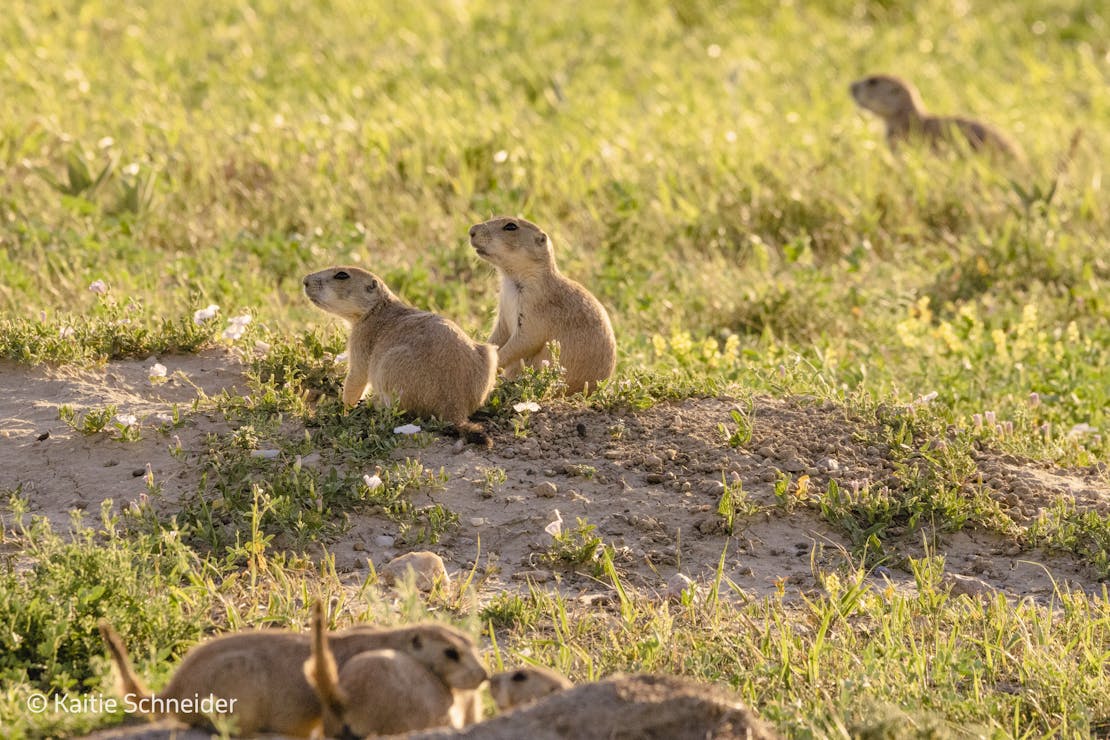Many consider February 2 to be Groundhog Day, but today, the western U.S. celebrates Prairie Dog Day as well. And there is plenty to celebrate and to learn when it comes to these burrowing mammals. In fact, we cannot talk about America’s iconic grasslands, endangered black-footed ferrets, Plains bison and the recovery of it all without talking about prairie dogs. You may know that prairie dogs and the burrows they build are of controversy, but whether you love them, hate them or just haven’t met them yet - this story is for you.
Prairie dogs are small, plump ground squirrels that construct sophisticated burrow systems, which can form mosaics of wild plants and unique niches for wild animals. Widely recognized as both a keystone species and ecosystem engineer, the benefits they bring run wild. As prairie dogs build and maintain their colonies, they clip vegetation, creating low lawns of diverse grassland. This is the preferred habitat for many grassland bird species, such as the mountain plover. The digging of the burrows mixes the soil, cycling nutrients and improving water retention. Prairie dog burrows provide homes and shelter for tiger salamanders, burrowing owls, endangered black-footed ferrets and many other species.
The prairie dogs themselves are an important food source for black-footed ferrets, swift foxes, golden eagles, red-tailed hawks, American badgers, prairie falcons and bobcats, amongst others. Researchers believe that more than 150 native species benefit from the presence of prairie dogs on a shared landscape.
Prairie dogs also have an incredibly complex social structure, outfitted with family units called “coteries” that make up neighborhoods across a prairie dog “town” or “colony.” The familiarity to humans doesn’t end there. Beneath the surface, their tunnels serve as hallways to specialized rooms for sleeping, storing food and raising babies. Impressively, their seemingly simple communication system of jumps, yips and calls warn every dog around of specific dangers approaching or where they are, even if that warning puts the prairie dog caller at risk – an act that is quite uncommon in the animal kingdom.
There are five species of prairie dogs that can only be found in North America: black-tailed, white-tailed, Utah, Mexican and Gunnison’s prairie dogs. Black-tailed prairie dogs are the most abundant with a much larger home range and most commonly what people refer to when you hear about prairie dogs. Despite how they may seem, prairie dogs are slow breeders, don’t migrate, and can regulate their own population sizes - they will stop breeding if their habitat cannot sustain their population size.
Despite all there is to love about these “barking squirrels” and “mound yappers,” prairie dogs have been pushed to near extinction in the past 150 years. While black-tailed prairie dogs are not on the endangered species list, this does not mean they are not imperiled. Prairie dog populations are under threat from habitat loss, eradication and sylvatic plague – a disease that can wipe out a colony in 14 days. Today it is estimated the black-tailed prairie dog population is only 2% of what it was 200 years ago. Large campaigns to exterminate black-tailed prairie dogs in the early 1900’s resulted in not only the loss of millions of acres of prairie dog colonies but also a negative stigma that the prairie dog is a pest incapable of coexisting with humans. Spoiler alert…that’s not true!
It is true that prairie dogs are not the perfect neighbor for everyone. Ranchers and agricultural producers may dislike prairie dogs because they fear the grazing competition, or they may simply find them to be a pest. However, prairie dogs can increase the quality of cattle forage and are more likely to colonize areas that cattle have already overgrazed. Did you know, they even help heal the soil and increase plant diversity, bringing huge value to farmers? Another increasingly notable benefit of their grazing behavior is that a colony can act as a wildfire break, granting an important glimpse into how prairie dogs evolved with, and impacted, fire frequent ecosystems of the West. Like many human-wildlife conflicts, who we consider pests truly comes down to perspective. For wildlife advocates, prairie dogs are the rockstars of the prairie.
What is Defenders Doing?
Defenders’ Rockies and Plains program has been engaged in prairie dog conservation for decades, and the impacts of our work are only growing.
As part of our cooperative recovery efforts with our Tribal partners, including the Fort Belknap and Crow Indian communities, Defenders helps conduct prairie dog conservation activities such as mapping active colonies to determine the available habitat for ferret recovery. Mapping efforts are also conducted by Defenders on private lands, such as Haverfield’s Ranch in Logan County, Kansas.
The Haverfield family is an iconic example of prairie protection on private lands. They believe that there should be places for prairie dogs in the grasslands, including their family-owned ranch. Over the years, we have helped the Haverfields with camera trap monitoring and building vegetation barriers around their property. Rather than shooting or poisoning prairie dogs who may venture near adjacent unwelcoming neighbors, coexistence tools like vegetation barriers consider the prairie dogs’ natural behaviors to keep them within the property line. As the only active reintroduction site for black-footed ferrets in Kansas, we are excited to continue supporting landowners like the Haverfields in building a family legacy of wildlife conservation.
Defenders also coordinates and serves on the steering committee of the Prairie Dog Coalition (PDC), which is rapidly becoming a hub for prairie dog information and action. Defenders and PDC, along with partners at the Humane Society of the United States, hosted our first two-day prairie dog coexistence workshop for government agencies and land managers last fall. This gave us the hands-on opportunity to discuss and explore nonlethal prairie dog management among peers from 20 different organizations. With outstanding feedback, several have begun incorporating these tools into their plans for 2023 and beyond. We hope to continue these conflict-resolution opportunities across the prairie dog’s range.
Another staple to prairie dog conservation is mitigating and preventing outbreaks of sylvatic plague, a non-native disease to which prairie dogs have no known immunity and which has devastated colonies on many black-footed ferret recovery sites. Defenders helps fund disease mitigation projects in key habitats to prevent sylvatic plague from spreading from infected fleas to prairie dogs. It is important work conserving and enhancing prairie dog habitat for ferret recovery efforts, especially as there are roughly only 400 ferrets in the wild.
What can you do?
Prairie dogs need something only humans can help with: social change. With greater appreciation and recognition of the species comes a push for agencies to better protect them. Whether you are a new or seasoned wildlife advocate, below are some steps you can take for the shortgrass steppe:
1. Add grasslands to your 2023 travel list. Beautiful public prairies include:
- Badlands National Park (SD).
- Buffalo Gap National Grassland (SD).
- Pawnee National Grassland (CO.)
- Soapstone Prairie Natural Area (CO).
- Rocky Mountain Arsenal (CO).
2. Support prairie dogs near you.
- Contact your elected officials and commissioners to voice your support for prairie dog conservation in your community. Check out these helpful tips.
- Attend town hall and community meetings, where developments on prairie dog colonies are often addressed.
3. Recreate responsibly in America’s grasslands.
- Do not let pets chase any wildlife, especially prairie dogs for the risk of spreading fleas.
- Stop the spread of invasive plants on prairies by brushing your boots and clothes off before leaving a park or trail.
- Pick up litter, even if it is not your own.
4. Help us spread a positive perception of prairie dogs. Keep learning and tell their story to those in your circle! The prairie appreciates every friend they can get.










Follow Defenders of Wildlife
facebook bluesky twitter instagram youtube tiktok threads linkedin